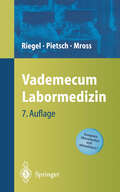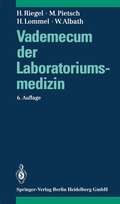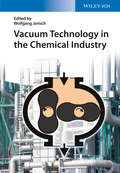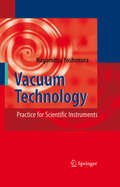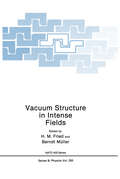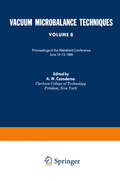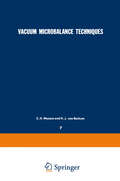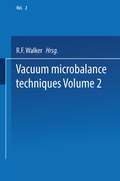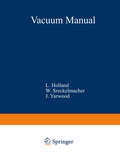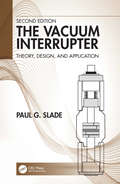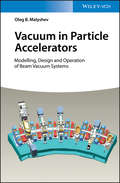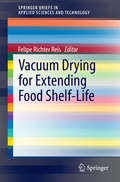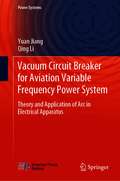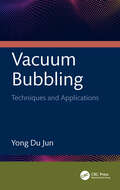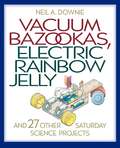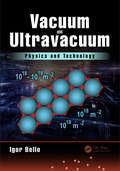- Table View
- List View
Vademecum der Laboratoriumsmedizin
by Helge Riegel Michael Pietsch Hermann Lommel Wolfgang AlbathDie vorliegende, völlig neu bearbeitete Auflage des "Vademecum der Laboratoriumsmedizin" orientiert sich an der rasanten Entwicklung der medizinischen Diagnostik und der daraus folgenden Therapie. Das Werk dient im medizinischen Alltag als rasche Orientierungshilfe bei der Interpretation und Bewertung labormedizinischer Befunde. Gleichzeitig ist das Vademecum ein Nachschlagewerk zur gezielten Anwendung medizinischer Laboruntersuchungen und gibt Hinweise zum erforderlichen Untersuchungsmaterial. Die alphabetische Auflistung der Analyte, Angaben zu Normalbereichen und Ursachen von Abweichungen hiervon, organbezogene Tabellen, ein Verzeichnis sämtlicher Indikationensowie ein Register der Analyte und Funktionsteste tragen entscheidend zur Benutzerfreundlichkeit bei.
Vacuum Technology in the Chemical Industry
by Wolfgang JorischBased on the very successful German edition and a seminar held by the German Engineers` Association (VDI) on a regular basis for years now, this English edition has been thoroughly updated and revised to reflect the latest developments. It supplies in particular the special aspects of vacuum technology, applied vacuum pump types and vacuum engineering in the chemical, pharmaceutical and process industry application-segments. The text includes chapters dedicated to latest European regulations for operating in hazardous zones with vacuum systems, methods for process pressure control and regulation and leak detection. All of the authors work or did work at a selection of the most important German companies involved in vacuum technology, and their expertise is disseminated here for engineers working in vacuum technology, chemical process design, plant operation, and mechanical engineering.
Vacuum Technology in the Chemical Industry
by Wolfgang JorischBased on the very successful German edition and a seminar held by the German Engineers` Association (VDI) on a regular basis for years now, this English edition has been thoroughly updated and revised to reflect the latest developments. It supplies in particular the special aspects of vacuum technology, applied vacuum pump types and vacuum engineering in the chemical, pharmaceutical and process industry application-segments. The text includes chapters dedicated to latest European regulations for operating in hazardous zones with vacuum systems, methods for process pressure control and regulation and leak detection. All of the authors work or did work at a selection of the most important German companies involved in vacuum technology, and their expertise is disseminated here for engineers working in vacuum technology, chemical process design, plant operation, and mechanical engineering.
Vacuum Technology: Practice for Scientific Instruments
by Nagamitsu YoshimuraIn this book, Yoshimura provides a review of the UHV related development during the last decades. His very broad experience in the design enables him to present us this detailed reference. After a general description how to design UHV systems, he covers all important issue in detail, like pumps, outgasing, Gauges, and Electrodes for high voltages. Thus, this book serves as reference for everybody using UVH in scientific equipment.
Vacuum Structure in Intense Fields (Nato Science Series B: #255)
by H. M. Fried Berndt MullerThis Advanced Study Institute (ASI) brought together two distinct ·"schools of approach" to Quantum Electrodynamics (QED) in the presence of intense, external, electromagnetic fields, in an effort to lay a joint foundation for a needed theoretical explanation of the sharp e+ e- "resonances" observed in the scattering of very heavy IOns. These (GSI/Darmstadt) experiments, whose history, latest reconfirmations, and most recent data were presented in three opening sessions (Bokemeyer, Koenig), show a smooth background of positron (e+) production, as a function of e+ kinetic energy. Superimposed upon this background are four very sharp peaks, of narrow widths (~ 30 KeV) and of clear experimental significance ('" 5 standard deviations). Most ofthese peaks correspond to sharp, essentially back-to-back electron-positron emission in the ions' center of mass. Following the approach of "supercritical" potential theory (SPT), where the total ionic charge unit Z satisfies Z > 137, it has been possible to provide a detailed and apparently correct understanding of the smooth e+ e- background; a coherent description of different facets of this approach, emphasizing the nature of the charged, supercritical vacuum, was described by the authors responsible for the invention of SPT (Greiner, Muller, Rafelski). In addition, predictions for related phenomena were outlined by other lecturers using the SPT approach (Bawin, Soff, SsJrensen).
Vacuum Microbalance Techniques: Volume 8 Proceedings of the Wakefield Conference, June 12–13, 1969
by A. W. CzandernaThis volume contains the proceedings of the Eighth Conference on Vacuum Microbalance Techniques held at Wakefield, Massachusetts on June 12 and 13, 1969. The tenth anniversary of the first confer ence will be registered as this volume passes through the typeset ting and proofreading stages. The eight volumes that have spawned from this continuing series of conferences now contain a total of 125 papers. Thus, these volumes serve as a major repository of the world's literature on vacuum microbalance techniques. The Ninth and Tenth Conferences will be held in West Germany in June 1970 and in Texas in 1971. Each of the eight meetings has served as a forum where new developments in this rapidly advancing field can be presented and discussed constructively within a conference atmosphere of cordial informality. The interaction of the participants at the conferences has led to the first treatise on ultra mlcrogravtmetry;' edited by S. P. Wolsky and E. J. Zdanuk, with most of the fourteen chapters written by steady contributors to the volumes on Vacuum Micro balance Techniques. The number of research investigations and published works in which a vacuum microbalance is utilized con tinues to expandr apldly. f This is a direct result of several types of automatic recording balances that are now available commercial ly. 3 The Eighth Conference was held to bring together again re search scientists and engineers who exploit the measurement of mass as a means of studying physical and chemical phenomena.
Vacuum Microbalance Techniques: Volume 7: Proceedings of the Eindhoven Conference June 17–18, 1968
by C. H. Massen H. J. BeckumVacuum Microbalance Techniques: Volume 2 Proceedings of the 1961 Conference Held at the National Bureau of Standards, Washington, D. C., April 20–21
by R. F. WalkerVacuum Manual
by L. HollandVacuum apparatus is widely used in research and industrial establishments for providing and monitoring the working environments required for the operation of many kinds of scientific instruments and process plant. The vacuum conditions needed range from the relatively coarse vacuum requirements in applications covering diverse fields such as food packaging, dentistry (investment casting), vacuum forming, vacuum metallur gical processes, vacuum impregnation, molecular distillation, vacuum drying and freeze drying etc. to the other extreme involving the highest possible vacuum as in particle accelerators, space technology -both in simulation and outer space, and research studies of atomically clean surfaces and pure condensed metal films. Vacua commence with the rough vacuum region, i.e. from atmosphere to 100 Pa * passing 6 through medium vacuum of 100 Pa to 0·1 Pa and high vacuum of 0·1 Pa to 1 J.lPa (10- Pa) until ultra high vacuum is reached below 1 J.lPa to the limit of measurable pressure about 12 I pPa (10- Pa).
The Vacuum Interrupter: Theory, Design, and Application
by Paul G. SladeTitle: The Vacuum Interrupter: Theory, Design, and ApplicationShelving guide: Electrical EngineeringDr. Paul Slade draws from his nearly six decades of active experience to develop this second edition of The Vacuum Interrupter: Theory, Design, and Application. This book begins by discussing the design requirements for high voltage vacuum interrupters and then the contact requirements to interrupt the vacuum arc. It then continues by describing the various applications in which the vacuum interrupter is generally utilized.Part 1 of this book begins with a detailed review of the vacuum breakdown process. It continues by covering the steps necessary for the design and the manufacture of a successful vacuum interrupter. The vacuum arc is then discussed, including how it is affected as a function of current. An overview of the development and use of practical contact materials, along with their advantages and disadvantages, follows. Contact designs that are introduced to control the high current vacuum arc are also analyzed.Part 2, on application, begins with a discussion of the arc interruption process for low current and high current vacuum arcs. It examines the voltage escalation phenomenon that can occur when interrupting inductive circuits. The occurrence of contact welding for closed contacts subjected to the passage of high currents, and for contacts when closing on high currents, is explored. The general requirements for the successful manufacture and testing of vacuum circuit breakers is then presented. The general application of vacuum interrupters to switch load currents, especially when applied to capacitor circuits, is also given. The interruption of high short circuit currents is presented along with the expected performance of the two major contact designs.Owing to the ever-increasing need for environmentally friendly circuit protection devices, the development and application of the vacuum interrupter will only increase in the future. At present the vacuum circuit breaker is the technology of choice for distribution circuits (5kV to 40.5kV). It is increasingly being applied to transmission circuits (72.5kV to 242kV). In the future, its application for protecting high voltage DC networks is assured.Audience This is a practical source book for engineers and scientists interested in studying the development and application of the vacuum interrupter Research scientists in industry and universities Graduate students beginning their study of vacuum interrupter phenomena Design engineers applying vacuum interrupters in vacuum switches, vacuum contactors, vacuum circuit breakers, and vacuum contactors It provides a unique and comprehensive review of all aspects of vacuum interrupter technology for those new to the subject and for those who wish to obtain a deeper understanding of its science and application Scientists and engineers, who are beginning their research into vacuum breakdown and aspects of the vacuum arc, will find the extensive bibliography and phenomenological descriptions to be a useful introduction
The Vacuum Interrupter: Theory, Design, and Application
by Paul G. SladeTitle: The Vacuum Interrupter: Theory, Design, and ApplicationShelving guide: Electrical EngineeringDr. Paul Slade draws from his nearly six decades of active experience to develop this second edition of The Vacuum Interrupter: Theory, Design, and Application. This book begins by discussing the design requirements for high voltage vacuum interrupters and then the contact requirements to interrupt the vacuum arc. It then continues by describing the various applications in which the vacuum interrupter is generally utilized.Part 1 of this book begins with a detailed review of the vacuum breakdown process. It continues by covering the steps necessary for the design and the manufacture of a successful vacuum interrupter. The vacuum arc is then discussed, including how it is affected as a function of current. An overview of the development and use of practical contact materials, along with their advantages and disadvantages, follows. Contact designs that are introduced to control the high current vacuum arc are also analyzed.Part 2, on application, begins with a discussion of the arc interruption process for low current and high current vacuum arcs. It examines the voltage escalation phenomenon that can occur when interrupting inductive circuits. The occurrence of contact welding for closed contacts subjected to the passage of high currents, and for contacts when closing on high currents, is explored. The general requirements for the successful manufacture and testing of vacuum circuit breakers is then presented. The general application of vacuum interrupters to switch load currents, especially when applied to capacitor circuits, is also given. The interruption of high short circuit currents is presented along with the expected performance of the two major contact designs.Owing to the ever-increasing need for environmentally friendly circuit protection devices, the development and application of the vacuum interrupter will only increase in the future. At present the vacuum circuit breaker is the technology of choice for distribution circuits (5kV to 40.5kV). It is increasingly being applied to transmission circuits (72.5kV to 242kV). In the future, its application for protecting high voltage DC networks is assured.Audience This is a practical source book for engineers and scientists interested in studying the development and application of the vacuum interrupter Research scientists in industry and universities Graduate students beginning their study of vacuum interrupter phenomena Design engineers applying vacuum interrupters in vacuum switches, vacuum contactors, vacuum circuit breakers, and vacuum contactors It provides a unique and comprehensive review of all aspects of vacuum interrupter technology for those new to the subject and for those who wish to obtain a deeper understanding of its science and application Scientists and engineers, who are beginning their research into vacuum breakdown and aspects of the vacuum arc, will find the extensive bibliography and phenomenological descriptions to be a useful introduction
Vacuum in Particle Accelerators: Modelling, Design and Operation of Beam Vacuum Systems
by Oleg B. MalyshevA unique guide on how to model and make the best vacuum chambers Vacuum in Particle Accelerators offers a comprehensive overview of ultra-high vacuum systems that are used in charge particle accelerators. The book?s contributors ? noted experts in the field ? also highlight the design and modeling of vacuum particle accelerators. The book reviews vacuum requirements, identifies sources of gas in vacuum chambers and explores methods of removing them. In addition, Vacuum in Particle Accelerators offers an in-depth explanation of the control of the beam and the beam aperture. In the final part of the book, the focus is on the modelling approaches for vacuum chambers under various operating conditions. This important guide: -Offers a review of vacuum systems in charge particle accelerators -Contains contributions from an international panel of noted experts in the field -Highlights the systems, modelling, and design of vacuum particle accelerators -Includes information on vacuum requirements, beam-gas interactions, cryogenic temperatures, ion induced pressure instability, heavy ion machines -Presents the most up-to-date information on the topic for scientists and engineers Written for vacuum physicists, vacuum engineers, plasma physicists, materials scientists, and engineering scientists, Vacuum Particle Accelerators is an essential reference offering an in-depth exploration of vacuum systems and the modelling and design of charged particle accelerators.
Vacuum in Particle Accelerators: Modelling, Design and Operation of Beam Vacuum Systems
by Oleg B. MalyshevA unique guide on how to model and make the best vacuum chambers Vacuum in Particle Accelerators offers a comprehensive overview of ultra-high vacuum systems that are used in charge particle accelerators. The book?s contributors ? noted experts in the field ? also highlight the design and modeling of vacuum particle accelerators. The book reviews vacuum requirements, identifies sources of gas in vacuum chambers and explores methods of removing them. In addition, Vacuum in Particle Accelerators offers an in-depth explanation of the control of the beam and the beam aperture. In the final part of the book, the focus is on the modelling approaches for vacuum chambers under various operating conditions. This important guide: -Offers a review of vacuum systems in charge particle accelerators -Contains contributions from an international panel of noted experts in the field -Highlights the systems, modelling, and design of vacuum particle accelerators -Includes information on vacuum requirements, beam-gas interactions, cryogenic temperatures, ion induced pressure instability, heavy ion machines -Presents the most up-to-date information on the topic for scientists and engineers Written for vacuum physicists, vacuum engineers, plasma physicists, materials scientists, and engineering scientists, Vacuum Particle Accelerators is an essential reference offering an in-depth exploration of vacuum systems and the modelling and design of charged particle accelerators.
Vacuum Flask (UEB uncontracted)
by RnibThis is a labelled cross section diagram of a vacuum flask (also called a Dewar flask or Thermos flask) seen from the side. There is a locator dot shown, which will be at the top left of the page when the image is the correct way up. The image of the flask fills the right half of the page. On the left of the page are descriptive labels with leader lines pointing to parts of the flask on the right.
Vacuum Flask (UEB contracted)
by RnibThis is a labelled cross section diagram of a vacuum flask (also called a Dewar flask or Thermos flask) seen from the side. There is a locator dot shown, which will be at the top left of the page when the image is the correct way up. The image of the flask fills the right half of the page. On the left of the page are descriptive labels with leader lines pointing to parts of the flask on the right.
Vacuum Flask (large print)
by RnibThis is a labelled cross section diagram of a vacuum flask (also called a Dewar flask or Thermos flask) seen from the side. There is a locator dot shown, which will be at the top left of the page when the image is the correct way up. The image of the flask fills the right half of the page. On the left of the page are descriptive labels with leader lines pointing to parts of the flask on the right.
Vacuum Drying for Extending Food Shelf-Life (SpringerBriefs in Applied Sciences and Technology)
by Felipe Richter ReisIn this book, suitable examples of how to increase the shelf life of food materials while preserving their desirable original features are provided.
Vacuum Circuit Breaker for Aviation Variable Frequency Power System: Theory and Application of Arc in Electrical Apparatus (Power Systems)
by Qing Li Yuan JiangThis book introduces the concepts of more electric aircraft and aviation electrical appliances, as well as the aviation experimental platform of vacuum switches, the interruption characteristics, frequency characteristics and post-arc breakdown characteristics of intermediate frequency vacuum switches, etc. It is the first monograph on protection electrical appliances, vacuum interrupter in aviation variable frequency power system. This book includes a lot of experimental process and chart analysis for readers to understand and provides references for practical engineering problems. This book could be used as references for engineers and technicians working on electric power systems in aircrafts.
Vacuum Bubbling: Techniques and Applications
by Yong Du JunVacuum Bubbling introduces the background and applications for generating bubbles under a vacuum condition, accomplished through depressurization without the need to heat water. It presents the advantage of utilizing vapor bubble in deaeration applications because the diffusion for degassing happens between the water body and micro vapor bubbles without the need of membrane or packing.Instead of relying on massive heating, vacuum bubbling focuses on depressurization down to the level of saturated vapor pressure or below to secure vapor bubbles with virtually zero dissolved non-condensable gases, including oxygen. The book considers prospective applications, such as extracting high-oxygen-content air from water for underwater breathing, pretreatment of aircraft fuel before being pumped into a fuel tank system, and probable desalination applications through massive bubbling combined with low-grade renewable energy.The book is intended for researchers in thermal fluids, heat and mass transfer, process engineering, and water treatment fields and industry professionals working in power generation, plant and process engineering, transportation, and energy.
Vacuum Bubbling: Techniques and Applications
by Yong Du JunVacuum Bubbling introduces the background and applications for generating bubbles under a vacuum condition, accomplished through depressurization without the need to heat water. It presents the advantage of utilizing vapor bubble in deaeration applications because the diffusion for degassing happens between the water body and micro vapor bubbles without the need of membrane or packing.Instead of relying on massive heating, vacuum bubbling focuses on depressurization down to the level of saturated vapor pressure or below to secure vapor bubbles with virtually zero dissolved non-condensable gases, including oxygen. The book considers prospective applications, such as extracting high-oxygen-content air from water for underwater breathing, pretreatment of aircraft fuel before being pumped into a fuel tank system, and probable desalination applications through massive bubbling combined with low-grade renewable energy.The book is intended for researchers in thermal fluids, heat and mass transfer, process engineering, and water treatment fields and industry professionals working in power generation, plant and process engineering, transportation, and energy.
Vacuum Bazookas, Electric Rainbow Jelly, and 27 Other Saturday Science Projects (PDF)
by Neil A. DownieHow do you crack nuts with a piece of string? Reverse gravity? Cobble together a clock out of a coffee cup, a soda bottle, and some water? Use a vacuum cleaner and nineteenth-century railroad technology to fashion a makeshift bazooka that can launch paper projectiles? Create a rainbow in a block of Jello? This is a one-volume romp through a whole array of counterintuitive science experiments that require little more than common household items and a sense of curiosity. Prepare to have your surprise sensors on overload as Neil Downie stretches math, physics, and chemistry to do what they have never done before. This book describes twenty-nine unusual but practical experiments, detailing how they are done and the math and physics behind them. It will delight both casual and inveterate tinkerers. Of varying levels of complexity, the experiments are grouped in sections covering a wide field of physics and the borders of chemistry, ranging from dynamic mechanics (''Kinetic Curiosities'') to electricity (''Antediluvian Electronics'') and combustion (''Infernal Inventions''). The chapters are titillatingly titled, from ''Twisted Sinews'' and ''Mole Radio'' to ''A Symphony of Siphons'' and ''Tornado Transistor.'' More-detailed explanations, along with simple mathematical models using high-school level math, are given in boxes accompanying each experiment. Armchair scientists will welcome this edifying and entertaining alternative to idleness, not least for the buoyant prose, enriched by historical and literary anecdotes introducing each topic. With this book in hand, tinkerers, whether dabblers in science or devotees, students or teachers, need never again wonder how to impress friends, the judges at the science fair, and, not least, themselves.
Vacuum Bazookas, Electric Rainbow Jelly, and 27 Other Saturday Science Projects
by Neil A. DownieHow do you crack nuts with a piece of string? Reverse gravity? Cobble together a clock out of a coffee cup, a soda bottle, and some water? Use a vacuum cleaner and nineteenth-century railroad technology to fashion a makeshift bazooka that can launch paper projectiles? Create a rainbow in a block of Jello? This is a one-volume romp through a whole array of counterintuitive science experiments that require little more than common household items and a sense of curiosity. Prepare to have your surprise sensors on overload as Neil Downie stretches math, physics, and chemistry to do what they have never done before. This book describes twenty-nine unusual but practical experiments, detailing how they are done and the math and physics behind them. It will delight both casual and inveterate tinkerers. Of varying levels of complexity, the experiments are grouped in sections covering a wide field of physics and the borders of chemistry, ranging from dynamic mechanics (''Kinetic Curiosities'') to electricity (''Antediluvian Electronics'') and combustion (''Infernal Inventions''). The chapters are titillatingly titled, from ''Twisted Sinews'' and ''Mole Radio'' to ''A Symphony of Siphons'' and ''Tornado Transistor.'' More-detailed explanations, along with simple mathematical models using high-school level math, are given in boxes accompanying each experiment. Armchair scientists will welcome this edifying and entertaining alternative to idleness, not least for the buoyant prose, enriched by historical and literary anecdotes introducing each topic. With this book in hand, tinkerers, whether dabblers in science or devotees, students or teachers, need never again wonder how to impress friends, the judges at the science fair, and, not least, themselves.
Vacuum and Ultravacuum: Physics and Technology
by Igor BelloVacuum technology has enormous impact on human life in many aspects and fields, such as metallurgy, material development and production, food and electronic industry, microelectronics, device fabrication, physics, materials science, space science, engineering, chemistry, technology of low temperature, pharmaceutical industry, and biology. All decorative coatings used in jewelries and various daily products—including shiny decorative papers, the surface finish of watches, and light fixtures—are made using vacuum technological processes. Vacuum analytical techniques and vacuum technologies are pillars of the technological processes, material synthesis, deposition, and material analyses—all of which are used in the development of novel materials, increasing the value of industrial products, controlling the technological processes, and ensuring the high product quality. Based on physical models and calculated examples, the book provides a deeper look inside the vacuum physics and technology.
Vacuum and Ultravacuum: Physics and Technology
by Igor BelloVacuum technology has enormous impact on human life in many aspects and fields, such as metallurgy, material development and production, food and electronic industry, microelectronics, device fabrication, physics, materials science, space science, engineering, chemistry, technology of low temperature, pharmaceutical industry, and biology. All decorative coatings used in jewelries and various daily products—including shiny decorative papers, the surface finish of watches, and light fixtures—are made using vacuum technological processes. Vacuum analytical techniques and vacuum technologies are pillars of the technological processes, material synthesis, deposition, and material analyses—all of which are used in the development of novel materials, increasing the value of industrial products, controlling the technological processes, and ensuring the high product quality. Based on physical models and calculated examples, the book provides a deeper look inside the vacuum physics and technology.
